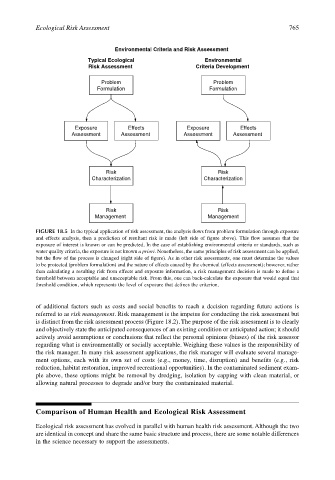Page 785 - The Toxicology of Fishes
P. 785
Ecological Risk Assessment 765
Environmental Criteria and Risk Assessment
Typical Ecological Environmental
Risk Assessment Criteria Development
Problem Problem
Formulation Formulation
Exposure Effects Exposure Effects
Assessment Assessment Assessment Assessment
Risk Risk
Characterization Characterization
Risk Risk
Management Management
FIGURE 18.5 In the typical application of risk assessment, the analysis flows from problem formulation through exposure
and effects analysis, then a prediction of resultant risk is made (left side of figure above). This flow assumes that the
exposure of interest is known or can be predicted. In the case of establishing environmental criteria or standards, such as
water quality criteria, the exposure is not known a priori. Nonetheless, the same principles of risk assessment can be applied,
but the flow of the process is changed (right side of figure). As in other risk assessments, one must determine the values
to be protected (problem formulation) and the nature of effects caused by the chemical (effects assessment); however, rather
than calculating a resulting risk from effects and exposure information, a risk management decision is made to define a
threshold between acceptable and unacceptable risk. From this, one can back-calculate the exposure that would equal that
threshold condition, which represents the level of exposure that defines the criterion.
of additional factors such as costs and social benefits to reach a decision regarding future actions is
referred to as risk management. Risk management is the impetus for conducting the risk assessment but
is distinct from the risk assessment process (Figure 18.2). The purpose of the risk assessment is to clearly
and objectively state the anticipated consequences of an existing condition or anticipated action; it should
actively avoid assumptions or conclusions that reflect the personal opinions (biases) of the risk assessor
regarding what is environmentally or socially acceptable. Weighing these values is the responsibility of
the risk manager. In many risk assessment applications, the risk manager will evaluate several manage-
ment options, each with its own set of costs (e.g., money, time, disruption) and benefits (e.g., risk
reduction, habitat restoration, improved recreational opportunities). In the contaminated sediment exam-
ple above, these options might be removal by dredging, isolation by capping with clean material, or
allowing natural processes to degrade and/or bury the contaminated material.
Comparison of Human Health and Ecological Risk Assessment
Ecological risk assessment has evolved in parallel with human health risk assessment. Although the two
are identical in concept and share the same basic structure and process, there are some notable differences
in the science necessary to support the assessments.

